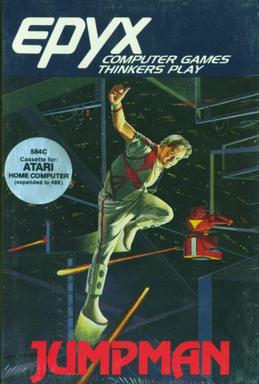
Jumpman is a platform game written by Randy Glover and published by Epyx in 1983. It was developed for the Atari 8-bit computers, and versions were also released for the Commodore 64, Apple II, and IBM PC compatibles.

Pole Position is a racing arcade video game released by Namco in 1982. It was licensed to Atari, Inc. for US manufacture and distribution. Pole Position is considered one of the most important titles from the golden age of arcade video games. It was an evolution of Namco's earlier arcade racing electro-mechanical games, notably F-1 (1976), whose designer Sho Osugi worked on Pole Position.

Epyx, Inc. was a video game developer and video game publisher active in the late 1970s and 1980s. The company was founded as Automated Simulations by Jim Connelley and Jon Freeman, originally using Epyx as a brand name for action-oriented games before renaming the company to match in 1983. Epyx published a long series of games through the 1980s. The company is currently owned by Bridgestone Multimedia Group Global.

B.C.'s Quest for Tires is an horizontally scrolling video game designed by Rick Banks and Michael Bate and published by Sierra On-Line in 1983. Versions were released for the Commodore 64, IBM PC, Atari 8-bit computers, ColecoVision, ZX Spectrum, MSX, and Apple II. Based on the comic strip B.C. by Johnny Hart, BC's Quest for Tires is similar to Irem's Moon Patrol from the previous year. A wheel-riding caveman is always moving forward through horizontally scrolling levels, and the player jumps or ducks as obstacles approach. The game's title is a play on the contemporaneous film Quest for Fire.

Stunt Car Racer is a racing video game developed by Geoff Crammond. It was published in 1989 by MicroProse, under their MicroStyle and MicroPlay labels in the United Kingdom and in the United States, respectively. The game pits two racers on an elevated track on which they race in a head-to-head competition, with ramps they must correctly drive off as the main obstacle.

Summer Games is a sports video game developed and published by Epyx based on sports from the Summer Olympic Games. Released in 1984 for the Commodore 64, it was ported to the Apple II, Atari 2600, Atari 7800, Atari 8-bit computers, and Master System.
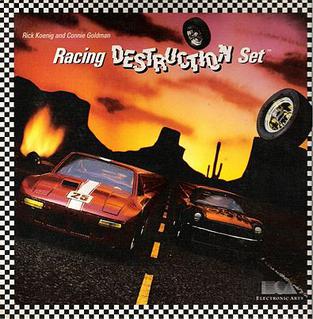
Racing Destruction Set is a racing video game published in 1985 for the Commodore 64 by Electronic Arts. It was advertised as being Commodore 128 compatible. A version for Atari 8-bit computers, programmed by Rebecca Heineman of Interplay, was released in 1986 in the United States, United Kingdom, and Germany. The game allows players to design and race on tracks with a variety of vehicles. It is part of the Construction Set series along with Pinball Construction Set, Music Construction Set, and Adventure Construction Set.
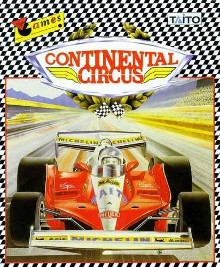
Continental Circus is a racing simulation arcade game, created and manufactured by Taito in 1987. In 1989, ports for the Amiga, Amstrad CPC, Atari ST, Commodore 64, MSX and ZX Spectrum were published by Virgin Games.
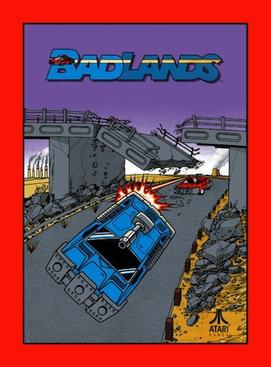
Badlands is a 1989 arcade video game published by Atari Games. It was ported by Domark under the Tengen label to the Amiga, Amstrad CPC, Atari ST, Commodore 64, and ZX Spectrum. The game is a re-themed version of Atari's previous racing games Super Sprint and Championship Sprint with the addition of vehicular combat. Badlands is set in the aftermath of a nuclear war and races around abandoned wastelands with many hazards. Three gun-equipped cars race around a track to win prizes.

Frogger II: ThreeeDeep! is a video game released in 1984 by Parker Brothers for the Apple II, Atari 8-bit computers, Atari 2600, Atari 5200, ColecoVision, Commodore 64, and IBM PC compatibles. It is a sequel to the 1981 Konami Frogger arcade video game and has similar gameplay.
Satoru Nakajima F-1 Hero is a video game developed by Human Entertainment released for the Nintendo Entertainment System in 1990. It starred American Indy car driver Michael Andretti, and featured the full sixteen-race schedule of the FIA Formula One World Championship circuit.
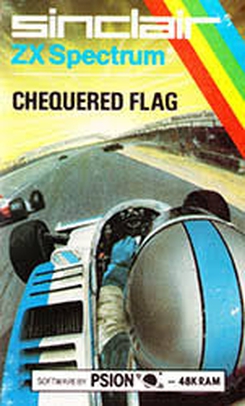
Chequered Flag is a racing video game developed by Psion Software and published by Sinclair Research in 1983. It was the first driving game published for the ZX Spectrum and one of the first computer car simulators.
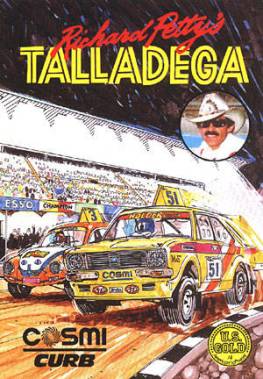
Richard Petty's Talladega is a racing game featuring Richard Petty and Talladega Superspeedway. It was published by Cosmi in 1984 for Atari 8-bit computers. A Commodore 64 port followed in 1985. It is the first home video game to feature NASCAR racers.

Pitstop II is a 1984 sequel to the 1983 racing game Pitstop, both of which were published by Epyx. Ported to more platforms than the original, Pitstop II was released for the Commodore 64, Atari 8-bit computers, and as a self-booting disk for IBM PC compatibles. Apple II and TRS-80 Color Computer versions were released in 1985.

The Dukes of Hazzard is a 1984 racing video game developed and published by Coleco for their ColecoVision game console and Coleco Adam computer. Elite Systems released a different game with the same title for the ZX Spectrum computer on February 23, 1985. Both versions are based on the television series of the same name.

Stock Car is an overhead-view racing video game written by A. W. Halse and published in the UK by Micro Power. It was released in 1984 for the BBC Micro, Acorn Electron, and Commodore 64 computers. Although the cassette inlay gives the release date as 1984, some sources state the release date as 1983, and the game is also known as Stock Car Racer.

Dragonriders of Pern is a video game published by Epyx in 1983 based on Anne McCaffrey's book series of the same name. The game was released for the Atari 8-bit computers and Commodore 64.

Hazard Run is a 1982 racing video game developed by Dennis R. Zander and published by Artworx for Atari 8-bit computers. In 1984, Artworx considered re-publishing the game as a tie-in to the television series The Dukes of Hazzard.
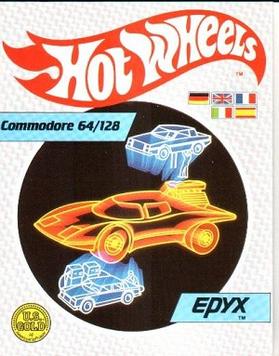
Hot Wheels is a racing video game developed by A. Eddy Goldfarb & Associates, and published by Epyx for the Commodore 64. The game was unveiled in June 1984, at Chicago's Summer Consumer Electronics Show, and was released later that year. Hot Wheels is the first video game to be based on the Hot Wheels toyline, and was marketed by Epyx as part of their Computer Activity Toys series, consisting of video games based on popular toylines.

Jumpman Junior is a platform game written by Randy Glover and published by Epyx in 1983 for the Atari 8-bit computers and Commodore 64. In 1984, a port was released for ColecoVision in Australia, France, Germany, Italy and the UK. It is a follow-up to Jumpman (1983). While Jumpman has 30 levels, Jumpman Junior has 12–all of which are different from the previous game. The game was reduced in scope so it could be released in cartridge form.





















